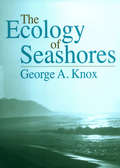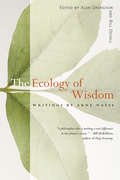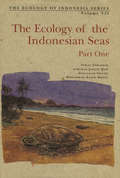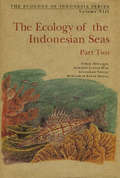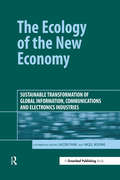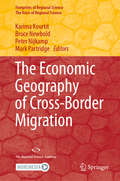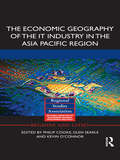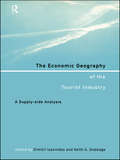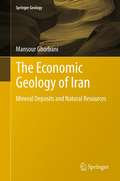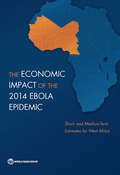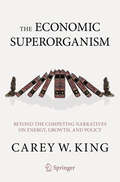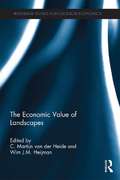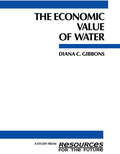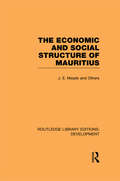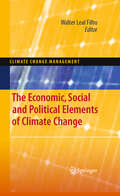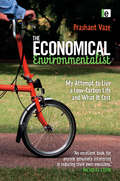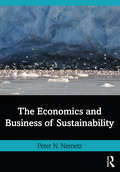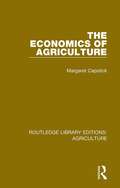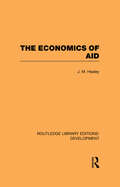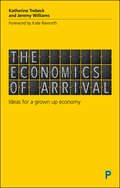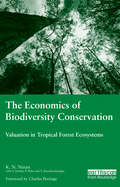- Table View
- List View
The Ecology of Seashores (CRC Marine Science)
by George A. KnoxThe Ecology of Seashores explores the complex shore environment. It covers the ways in which representative species have adapted to life in a constantly changing environment in terms of their interactions, the control of community structure, and how energy and materials are cycled in different ecosystems.Written by an eminent marine biologist,
The Ecology of Wisdom: Writings by Arne Naess
by Arne Naess Bill Devall Alan DrengsonA founder of the Deep Ecology Movement, Arne Naess' has produced articles on environmentalism that have provided unmatched inspiration for ecologists, philosophers, and activists worldwide. This collection amasses a definitive group of Naess' most important works in which he calls for nonviolent, cooperative action to protect the Earth. Rich with observations, insights, and anecdotes, Naess' writings draw from Eastern religious practices, Gandhian nonviolent direct action, and Spinozan unity systems. Playful and compassionate in tone, Ecology of Wisdom showcases Naess' exceptional enthusiasm, wit, and spiritual fascination with nature, while educating each of us about the steps we must take to rescue the planet and illuminating the relevance of this important environmental advocate.
The Ecology of the Indonesian Seas Part One
by Mohammad Kasim Moosa Anugerah Nontji Tomas Tomascik Anmarie J. MahThe challenging task of documenting Indonesia's marine realm is presented here in a two-volume set.The first volume provides a review of the geology, physical oceanography and meteorology of the archipelago.The second volume discusses the origins, formation and distribution of various reef types in the Indonesian Archipelago, and provides new estimates on their extent. The second volume also provides a review of the ecology of Indonesian seagrass, mangrove and open-ocean ecosystems. The final two chapters discuss what effects the human race has had on marine resources, and what we can do to protect and preserve our marine and coastal zones for generations to come.
The Ecology of the Indonesian Seas Part Two
by Mohammad Kasim Moosa Anugerah Nontji Tomas Tomascik Anmarie J. MahThe Ecology of the Indonesian Seas distills for the first time the information found in thousands of scholarly works relevant to an understanding of the sustainable use of marine and coastal resources in these islands--many of them available up to now only in Dutch, German or Indonesian.<P><P> It is an invaluable tool for government planners, resource managers, ecologists, university students, scuba divers, and all those with an interest in the sea.The second volume discusses the origins, formation and distribution of various reef types in the Indonesian Archipelago, and provides new estimates on their extent. The second volume also provides a review of the ecology of Indonesian seagrass, mangrove and open-ocean ecosystems. The chapter on marine biodiversity focuses on a number of marine and coastal habitats and threatened marine organisms. The final two chapters discuss what recent effects the human race has had on marine resources, and what we can do to protect and preserve our marine and coastal zones for generations to come.
The Ecology of the New Economy: Sustainable Transformation of Global Information, Communications and Electronics Industries
by Jacob Park Nigel RoomeA "revolution" is taking place in the development of global information and communications technologies. In slightly more than a decade, the World Wide Web has gone from the idea of an obscure English scientist to a consumer-oriented technology system with an expected one billion users by 2005. The technologies that enable this to happen are advancing rapidly, which is leading to both an unprecedented number of start-up companies and a host of innovative new alliances between companies. The growth has been so rapid and unexpected that little research and analysis has yet been done on what impact this transformation has had or will have on the ability of companies to meet the global sustainability challenge. As environmental strategy has traditionally been portrayed in terms of risk cutting and resource efficiency, there is a danger that critical business issues such as information technology, R&D and e-commerce development are examined in isolation from the wider sustainable business perspective. An important objective of the book is to explore, document and raise awareness of sustainability concerns arising from the emerging global information economy. The information economy is defined in the broadest sense possible, including software, hardware, telecommunication – traditional and wireless – and advanced communication technologies. Some of the key issues and questions that are examined include:Case studies on how and to what degree sustainability concerns are being integrated into the business model of electronic, telecommunication and dot.com firms. The relationship between the diffusion of information and communication technologies and the energy and resource intensity of companies. The role of information and communication technologies in the shaping of policies for sustainability, its impacts on sustainable or unsustainable lifestyles and its implications for the interaction between companies and other actors. Corporations and the global digital divide. The Ecology of the New Economy will be of interest to academics, governments, businesses, and non-governmental groups who are trying to understand the linkages and relationship between the two of our greatest global challenges: the information revolution and environmental sustainability.
The Economic Geography of Cross-Border Migration (Footprints of Regional Science)
by Peter Nijkamp Karima Kourtit Bruce Newbold Mark PartridgeThis handbook presents a collection of high-quality, authoritative scientific contributions on cross-border migration, written by a carefully selected group of recognized migration experts from around the globe. In recent years, cross-border migration has become an important and intriguing issue, from both a scientific and policy perspective. In the ‘age of migration’, the volume of cross-border movements of people continues to rise, while the nature of migration flows – in terms of the determinants, length of stay, effects on the sending and host countries, and legal status of migrants – is changing dramatically. Based on a detailed economic-geographical analysis, this handbook studies the motives for cross-border migration, the socio-economic implications for sending countries and regions, the locational choice determinants for cross-border migrants, and the manifold economic-geographic consequences for host countries and regions. Given the complexity of migration decisions and their local or regional impacts, a systematic typology of migrants (motives, legal status, level of education, gender, age, singles or families, etc.) is provided, together with an assessment of push factors in the place of origin and pull factors at the destination. On the basis of a solid analytical framework and reliable empirical evidence, it examines the impacts of emigration for sending areas and of immigration for receiving areas, and provides a comprehensive discussion of the policy dimensions of cross-border migration.
The Economic Geography of the IT Industry in the Asia Pacific Region: Economic Geography Of The It Industry In The Asia Pacific Region (Regions and Cities #67)
by Kevin O'Connor Philip Cooke Glen SearleThe development of the information technology (IT) industry in the Asia Pacific region faces two challenges. Firstly, can its established physical, technical, regional and governance infrastructures be adapted to meet the challenges embedded in the set of products and processes created by the IT industry? Secondly, as this adaptation evolves, which cities and regions will be best suited to connect to or lead global responses to these challenges? The chapters in this book have set out to explore these questions, providing details of change in a range of aspects of the IT industry such as mobile phones, software services, and flat screen design in regions in Japan, Korea, Taiwan, India, China and Australia. The book also outlines the policy responses of national and regional governments in Singapore, India and China and India. These case studies provide a basis to understand effective strategies which could be formulated for the future. This book’s originality emerges from the fine detail provided about firms, in particular regions and cities, from research carried out by young scholars in the past two years. This makes it very useful for readers keen to understand the recent changes in this dynamic industry in a fast growth part of the world, and it will also help to shape thinking by policy makers on policy settings that can be applied.
The Economic Geography of the Tourist Industry: A Supply-Side Analysis
by Dimitri Ioannides Keith G. DebbageThe Economic Geography of the Tourist Industry bridges the gap between tourism research and economic geography by bringing together leading academics in geography, planning and tourism. The authors explain tourism's definitions and examine whether tourism can be categorized as an industry. They provide detailed analyses of key sectors, such as tour
The Economic Geography of the UK
by Andrew Jones Dr Neil CoeWith the UK still facing the repercussions of the 2007 economic downturn, Coe and Jones' text is a timely, engaging discussion of the key issues facing the UK economy from a purely geographical perspective, written by some of the leading academics in the field. With pedagogical features to facilitate learning, including further reading and chapter aims, the text explores the complex connections that constitute the UK economy including the city and finance, the uneven development of the UK, the UK economy's links to the European Union and its wider ties to the global economy. Written for geography students studying modules on economic geography and the human geography of the UK, the text is a vibrantly written, easy-to-understand analysis of the current and future challenges that face the contemporary UK economy. Includes a preface by Doreen Massey.
The Economic Geology of Iran
by Mansour GhorbaniThe Economic Geology of Iran is a complete and comprehensive book about mineral deposits, energy and water resources of Iran. Dr. Mansour Ghorbani has travelled to each of the huge variety of locations that feature the resources covered, personally verifying the details of them all. The book starts by describing the geography and physiography of Iran as well as its various climatic regions and the diverse corresponding vegetation. Then the book gives an excellent overview of the geology of the country, followed by the history of mining in Iran up to now. The author describes also the metallogenic and mineralization phases of Iran, its mineral zones and belts, and, more generally, the distribution of mineral deposits in the country. Dr. Ghorbani gives us also an analysis of the position of Iran in terms of global mineral resources, as well as the role that the country's mineral, energy and natural resources play in its overall economy. The book finishes with also provides a complete list of Iranian mineral deposits. This book is a perfect source of information for all students and researchers in the field of geo-science at the university level but also for mining and oil companies that would like to work, invest and get involved in such businesses in Iran.
The Economic Geology of Iran: Mineral Deposits and Natural Resources (Springer Geology)
by Mansour GhorbaniThe Economic Geology of Iran is a complete and comprehensive book about mineral deposits, energy and water resources of Iran. Dr. Mansour Ghorbani has travelled to each of the huge variety of locations that feature the resources covered, personally verifying the details of them all. The book starts by describing the geography and physiography of Iran as well as its various climatic regions and the diverse corresponding vegetation. Then the book gives an excellent overview of the geology of the country, followed by the history of mining in Iran up to now. The author describes also the metallogenic and mineralization phases of Iran, its mineral zones and belts, and, more generally, the distribution of mineral deposits in the country. Dr. Ghorbani gives us also an analysis of the position of Iran in terms of global mineral resources, as well as the role that the country’s mineral, energy and natural resources play in its overall economy. The book finishes with also provides a complete list of Iranian mineral deposits. This book is a perfect source of information for all students and researchers in the field of geo-science at the university level but also for mining and oil companies that would like to work, invest and get involved in such businesses in Iran.
The Economic Impact of the 2014 Ebola Epidemic
by The World BankBeyond its terrible toll in human lives and suffering, the Ebola epidemic has inflicted a measurable economic impact on West Africa in terms of forgone output, higher fiscal deficits, rising prices, lower real household incomes, and greater poverty. This impact results partly from the health-care costs and forgone productivity associated with being infected, but it is driven principally by the efforts of the uninfected population to avoid exposure ('aversion behavior'). The Economic Impact of the 2014 Ebola Epidemic: Short- and Medium-Term Estimates for West Africa provides a mixed methods analysis of the economic impact, combining theory on the channels of economic impact of the epidemic, economic indicators across sectors in the affected countries, and models of how these economies interact with each other and with the broader world. The result is a quantification of the potential overall magnitude of the economic impact for Guinea, Liberia, and Sierra Leone, as well as for West Africa as a whole. Ebola's short-term economic impact (2014) in the three core countries is on the order of US$359 million in forgone output: That is how much poorer these economies will be than they would have been in the absence of Ebola. Two alternative scenarios are used to estimate the medium-term impact (2015): A Low Ebola scenario corresponds to rapid containment within the three most severely affected countries and limited regional contagion, and a High Ebola scenario corresponds to slower containment in the three core countries with broader regional contagion. The estimates of the output lost as a result of the epidemic in the three core countries for 2015 alone sum to US$97 million under the Low Ebola scenario (implying some recovery from 2014) and US$809 million under the High Ebola scenario. Over the medium term, however, epidemiological and economic contagion are likely in the broader sub-region of West Africa. This report uses a multi-country general equilibrium model to estimate the medium-term impact on output for West Africa as a whole. Under the Low Ebola scenario, the loss in GDP for the sub-region is estimated to be US$2.2 billion in 2014 and US$1.6 billion in 2015. Under the High Ebola scenario, the estimates are US$7.4 billion in 2014 and US$25.2 billion in 2015. These are major regional impacts with global implications. This report will be of particular interest to policy makers and others interested in understanding the broader impact of the Ebola epidemic and in assisting with the subsequent economic recovery.
The Economic Superorganism: Beyond the Competing Narratives on Energy, Growth, and Policy
by Carey W. KingEnergy drives the economy, economics informs policy, and policy affects social outcomes. Since the oil crises of the 1970s, pundits have debated the validity of this sequence, but most economists and politicians still ignore it. Thus, they delude the public about the underlying influence of energy costs and constraints on economic policies that address such pressing contemporary issues as income inequality, growth, debt, and climate change. To understand why, Carey King explores the scientific and rhetorical basis of the competing narratives both within and between energy technology and economics. Energy and economic discourse seems to mirror Newton’s 3rd Law of Motion: For every narrative there is an equal and opposite counter-narrative. The competing energy narratives pit "drill, baby, drill!" against renewable technologies such as wind and solar. Both claim to provide secure, reliable, clean, and affordable energy to support economic growth with the most benefit to society, but how? To answer this question, we need to understand the competing economic narratives, techno-optimism and techno-realism. Techno-optimism claims that innovation overcomes any physical resource constraints and enables the social outcomes and economic growth we desire. Techno-realism, in contrast, states that no matter what energy technologies we use, feedbacks from physical growth on a finite planet constrain economic growth and create an uneven distribution of social impacts. In The Economic Superorganism, you will discover stories, data, science, and philosophy to guide you through the arguments from competing narratives on energy, growth, and policy. You will be able to distinguish the technically possible from the socially viable, and understand how our future depends on this distinction.
The Economic Value of Landscapes (Routledge Studies in Ecological Economics)
by C. Martijn van der Heide Wim J.M. HeijmanThis book aims to explore the avenue of landscape economics and provides the building blocks (from different scientific disciplines) for an economic analysis of landscapes. What exactly constitutes and determines the value of a landscape? It focuses on the value of landscapes in its broadest sense, thereby covering a variety of topics including stakeholder involvement in landscape design, landscape governance and landscape perceptions from different countries. Merely saying that landscapes have value or are important is not sufficient – not when resources are scarce and have alternative uses. Measuring and quantifying the economic value of changes in landscapes would help ensure that landscape management decisions are both (economically) rational and sound.
The Economic Value of Water
by Diana C. GibbonsGibbons examines the water supply problem through five case studies. The problems faced by these regions and the methods suggested to overcome them provide excellent models for the entire United States. The case studies---typically, expanding supplies---but economic efficiency principles lead to emphasizing managing the demand. In many cases, this means reducing demand by raising prices.
The Economic and Social Structure of Mauritius (Routledge Library Editions: Development)
by James E MeadeFirst published in 1961, this reissue examines the contemporary economic problems of Mauritius alongside those social problems which have a bearing on economic development. As a small and isolated economy, marked by a very rapid rate of contemporary population growth, by an extreme concentration on a single product, and by a great diversity of racial, religious and linguistic groups within the population, Mauritius is a representative microcosm of the economic problems of a large part of the developing world. The book considers the impact of a lower birth rate, emigration and economic development upon the economy of Mauritius, examining in detail the labour market, the prospects for agricultural and industrial development, the financial system and the education system.
The Economic, Social and Political Elements of Climate Change
by Walter Leal FilhoA unique feature of this book is its strong practice-oriented nature: it contains a wide range of papers dealing with the social, economic and political aspects of climate change, exemplifying the diversity of approaches to climate change management taking place all over the world, in a way never seen before. In addition, the book describes a number of projects and other initiatives happening in Africa, Asia, Europe, Latin American and the Australasian region, providing a profile of the diversity of works taking place today.
The Economical Environmentalist: My Attempt to Live a Low-Carbon Life and What it Cost
by Prashant VazeReducing your carbon emissions in an economic down-turn can be challenging, but saving the planet doesn't have to cost you more. Tough economic times need not relegate concerns for the planet to the back burner. The author is an environmental economist trying to live a low-carbon life in London. He worked for 15 years in the UK's Office of Climate Change, the Prime Minister's Strategy Unit and the Department of the Environment. So far so good. But he has kids. A family to visit in India. A hectic job. In distilling and building on his own experience of trying to live a low carbon life, he helps us navigate the choices that confront us all - families, singletons, pensioners - when making decisions about what to eat, what to buy, how to travel and how to keep warm in the era of climate change and economic turmoil. He works out the sums and lets us know which choices will make the biggest difference, and which are false savings. His book is an irreverent but seriously rigorous reference guide to low-cost, low-carbon living for everyone - in any location - in tough times. It's brimming with up-to-date information on current and future technologies, tips and ideas for every budget on how to spend the least for the biggest carbon reduction gain and insight from the experiences of people trying to live low-carbon lives.
The Economics and Business of Sustainability
by Peter N. NemetzGiven the emergence of sustainability as the defining issue of our time, it is essential for university graduates, and especially business and economics students, to have a fundamental grasp of the key issues in this emerging multidisciplinary field of study. Nemetz provides a comprehensive, detailed overview of the interlinked economic and ecological concepts central to this new discipline. Accompanying the introduction of the underlying theory is a broad array of real-world supporting data from Asia, Europe and North America. This volume also features a chapter on the threat of emerging pandemics and their significance for the achievement of a truly sustainable world. This book accentuates the value and importance of a strong sustainability approach in an age of climate change emergency. It is an ideal companion for instructors and students of sustainability in business, economics and related disciplines such as geography and political science.
The Economics of Agriculture (Routledge Library Editions: Agriculture #11)
by Margaret CapstickFirst published in 1970. The aim of this book is to provide an introduction to the special problems of agriculture in modern economies. The author writes for students of economics who have already acquired the elements of economic theory; no attempt is made, therefore, to explain simple theoretical concepts, but instead these are used in the analysis of some of the main problems of agricultural adjustment. Emphasis is placed on the position of agriculture in the economies of western Europe and of the United States. Sufficient historical background is given to explain the present use of the factors of production in agriculture and the way in which this use and policies of agricultural support vary from one country to another. Agricultural support policies are discussed with reference to their effect on consumers, producers and on rural society.
The Economics of Aid (Routledge Library Editions: Development)
by J. M. HealeyFirst published in 1971, this reissue considers the main aspects of foreign aid to developing countries in terms of economic concepts and principles. The author gives an economic definition of aid and considers the motives for giving aid and the principles on which it may be allocated. He looks at the effect on the economic growth of developing countries of both the aid given and the need to repay the debt, and the effect on trade patterns and resource allocation of tying aid to one particular project, or one source of goods. While economic analysis is only a first step in providing a basis for policy decisions on foreign aid, Dr Healey shows that many issues can be clarified by looking at them from the economists’ point of view.
The Economics of Air Pollution in China: Achieving Better and Cleaner Growth
by Jun MaSuffocating smog regularly envelops Chinese metropolises from Beijing to Shanghai, clouding the future prospect of China's growth sustainability. Air pollutants do not discriminate between the rich and the poor, the politician and the "average Joe." They put everyone's health and economic prosperity at risk, creating future costs that are difficult to calculate. Yet many people, including some in China, are concerned that addressing environmental challenges will jeopardize economic growth. In The Economics of Air Pollution in China, leading Chinese economist Ma Jun makes the case that the trade-off between growth and environment is not inevitable. In his ambitious proposal to tackle severe air pollution and drastically reduce the level of so-called PM 2.5 particles—microscopic pollutants that lodge deeply in lungs—Ma Jun argues that in targeting pollution, China has a real opportunity to undertake significant structural economic reforms that would support long-term growth. Rooted in rigorous analyses and evidence-based projections, Ma Jun's "big bang" proposal aims to mitigate pollution and facilitate a transition to a greener and more sustainable growth model.
The Economics of Air Pollution in China: Achieving Better and Cleaner Growth
by Ma JunSuffocating smog regularly envelops Chinese metropolises from Beijing to Shanghai, clouding the future prospect of China's growth sustainability. Air pollutants do not discriminate between the rich and the poor, the politician and the "average Joe." They put everyone's health and economic prosperity at risk, creating future costs that are difficult to calculate. Yet many people, including some in China, are concerned that addressing environmental challenges will jeopardize economic growth.In The Economics of Air Pollution in China, leading Chinese economist Ma Jun makes the case that the trade-off between growth and environment is not inevitable. In his ambitious proposal to tackle severe air pollution and drastically reduce the level of so-called PM 2.5 particles-microscopic pollutants that lodge deeply in lungs-Ma Jun argues that in targeting pollution, China has a real opportunity to undertake significant structural economic reforms that would support long-term growth. Rooted in rigorous analyses and evidence-based projections, Ma Jun's "big bang" proposal aims to mitigate pollution and facilitate a transition to a greener and more sustainable growth model.
The Economics of Arrival: Ideas for a Grown-Up Economy
by Jeremy Williams Katherine TrebeckWhat do we want from economic growth? What sort of a society are we aiming for? In everyday economics, there is no such thing as enough, or too much, growth. Yet in the world’s most developed countries, growth has already brought unrivalled prosperity: we have ‘arrived’. More than that, through debt, inequality, climate change and fractured politics, the fruits of growth may rot before everyone has a chance to enjoy them. It’s high time to ask where progress is taking us, and are we nearly there yet? In fact, Trebeck and Williams claim in this ground-breaking book, the challenge is now to make ourselves at home with this wealth, to ensure, in the interests of equality, that everyone is included. They explore the possibility of ‘Arrival’, urging us to move from enlarging the economy to improving it, and the benefits this would bring for all.
The Economics of Biodiversity Conservation: Valuation in Tropical Forest Ecosystems
by K.N NinanEconomic valuation of biodiversity and ecosystem services is possibly the most powerful tool for halting the loss of biodiversity while maintaining incomes and livelihoods. Yet rarely have such approaches been applied to tropical forest ?hotspots?, which house the vast majority of the planets plant and animal species. This ground-breaking work is the most comprehensive and detailed examination of the economics of environmental valuation and biodiversity conservation to date. Focusing on the Western Ghats of India, one of the top biodiversity hotspots in the world, this volume looks at a cross-section of local communities living within or near sanctuaries and reserve forests such as coffee growers, indigenous people and farmers-cum-pastoralists to assess the use and non-use values that people derive from tropical forests. It also looks at the extent of their dependence on forests for various goods and services, and examines their perceptions and attitudes towards biodiversity conservation and wildlife protection. The book concludes with an assessment of the institutional alternatives and policies for promoting biodiversity conservation through economic valuation methods. Related titles Economics for Collaborative Environmental Management (2005) 1-84407-095-6
